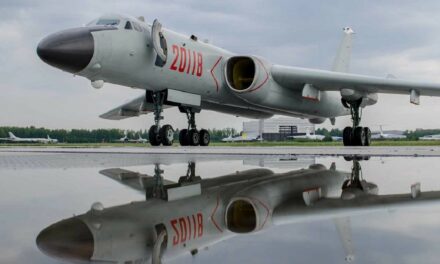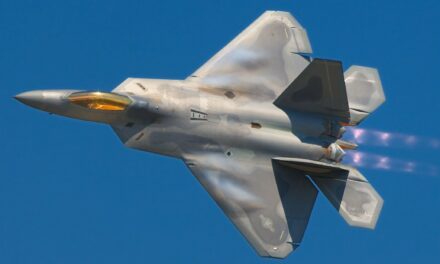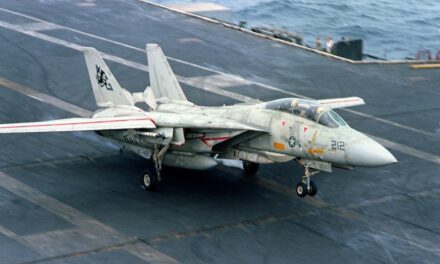We support our Publishers and Content Creators. You can view this story on their website by CLICKING HERE.
Key Points: The F-15I Ra’am, Israel’s customized version of the F-15E Strike Eagle, is a dual-role fighter excelling in air superiority and long-range strike missions.
Introduced in 1998, it features Israeli-designed avionics, helmet-mounted sights, and advanced targeting systems.
-Powered by two Pratt & Whitney F100-PW-229 engines, the F-15I achieves speeds up to Mach 2.5 and carries up to 23,000 pounds of munitions, including precision-guided weapons and air-to-air missiles. Known for its extended range and combat effectiveness, the Ra’am has been crucial in conflicts like the 2006 Lebanon War and Gaza operations.
-Regular upgrades ensure its relevance against modern threats.
F-15I Ra’am: The Backbone of Israel’s Air Superiority
We told you about the F-35I Adir, which means “Mighty One” in Hebrew, but before the fifth-generation stealth fighter proliferated in Israel, there is a workhorse called the F-15I Ra’am (“Thunder”) that is Israel’s main fighter.
The Ra’am is for dual-role combat that entails aircraft interception and ground strike. The F-15I has been an Israeli staple since 1998. Currently, it has been busy against surface targets in Gaza, Lebanon, and Syria and remains Israel’s go-to fighter due to its ample numbers and multi-mission roles.
Sniper: The F-15I Kills Hezbollah Terror Mastermind
It was a strike mission from F-15I Ra’ams that reportedly killed infamous Hezbollah terrorist leader Hassan Nasrallah on September 27. This was called Operation New Order and consisted of the F-15Is dropping 2,000-pound JDAM “bunker buster” bombs on a structure hiding the terror henchmen who were responsible for killing so many Americans and Israelis over the decades.
The strike was carried out by F-15Is from 69th Squadron from Hatzerim Airbase in southern Israel.
Busting Bunkers With Ease
The F-15I bunker busters drilled deep into the ground to destroy Nasrallah’s command and control center in the Dahiyeh suburb of Beirut, Lebanon. It took several of the specialty bombs to eliminate the target.
F-15I
Squadron leader Lt. Col. ‘Mem’ (Israeli pilots do not reveal last names in the media) said that “everything went smoothly” in the effort to kill Nasrallah. According to an Israeli Air Force general, the complex mission was executed without any enemy counter-fire.
Israel opted for overwhelming strike capabilities. Photos from the Israeli Air Force showed eight F-15Is, each loaded with seven JDAMs GPS-guided bunker busters with steel penetrator warheads.
Cousin of the American F-15E Strike Eagle
The F-15I Ra’am is developed from the U.S. Air Force’s F-15E Strike Eagle. The Ra’am has excellent range (2,700 miles without aerial refueling) and can fly farther than the F-35I or F-16I. It can carry 18,000 pounds of fuel and munitions.
The F-15I has unique enhancements that enable the Israeli Air Force to be so effective against ground targets hiding terrorists. The F-15I carries more weapons than other aircraft in the Israeli fleet with a wide assortment of air-to-air missiles.
It’s Tactical and Strategic
There is an Israeli-made main computer, an Elbit display, and a sight helmet. The F-15I is believed to have the capability to deliver nuclear weapons, although the potential use is highly classified. However, the F-15I is recognized as a strategic airplane.

F-15I. Image Credit: Creative Commons.
All-weather Strike Capability for F-15I
Maya Carlin, a defense analyst for the National Interest, described the F-15I’s advantages. “Among the IAF’s advancements include an APG-70 radar with terrain mapping capability. This feature provides a sharp picture that allows the crew to locate targets regardless of weather conditions.”
The dual-seat F-15I also features the LANTIRN for acquiring targets and administering missile lock against enemy fighters in aerial combat. There is a FLIR (Forward-Looking Infrared) system for better navigation and ability to sniff out ground targets in all weather conditions and at night.
Dual Engines with Surprising Power
Two Pratt & Whitney F100-PW-229 engines have a maximum thrust of 29,000 pounds each and can enable a speed of greater than MACH 2 at high altitude.
Flying Dog of War
The F-15I will continue to be a mainstay in the Israeli Air Force. It has been in service for nearly three decades. Israeli pilots are used to flying it at a high operational tempo, and it has the range for difficult missions that require pinpoint accuracy to destroy ground targets in Lebanon, Gaza, and Syria. Combining this fighter with the F-35I gives Israel a diversified punch in battle.
Due to its success in taking out Nasrallah, look for the F-15I to be the leader in eliminating targets deep underground. Terrorists in Gaza and Lebanon think they are safe in underground structures, but an F-15I loaded with bunker-buster bombs is up to the task of taking out the leadership of Hezbollah and Hamas.

Image: Creative Commons. Image is of a F-15I.
The terrorists never know what hit them, even though they think they are invincible. The F-15I will emerge with a bigger role when it comes to taking out the leadership network of terror groups, which are acts of vengeance against those who attack Israel.
The F-15I allows the Israelis to better bring down “thunder” against adversaries.
About the Author: Dr. Brent M. Eastwood
Brent M. Eastwood, PhD, is the author of Don’t Turn Your Back On the World: a Conservative Foreign Policy and Humans, Machines, and Data: Future Trends in Warfare, plus two other books. Brent was the founder and CEO of a tech firm that predicted world events using artificial intelligence. He served as a legislative fellow for U.S. Senator Tim Scott and advised the senator on defense and foreign policy issues. He has taught at American University, George Washington University, and George Mason University. Brent is a former U.S. Army Infantry officer. He can be followed on X @BMEastwood.

 Conservative
Conservative  Search
Search Trending
Trending Current News
Current News 





